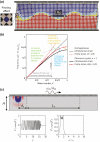Emerging topics in nanophononics and elastic, acoustic, and mechanical metamaterials: an overview
- PMID: 39679340
- PMCID: PMC11636487
- DOI: 10.1515/nanoph-2022-0671
Emerging topics in nanophononics and elastic, acoustic, and mechanical metamaterials: an overview
Abstract
This broad review summarizes recent advances and "hot" research topics in nanophononics and elastic, acoustic, and mechanical metamaterials based on results presented by the authors at the EUROMECH 610 Colloquium held on April 25-27, 2022 in Benicássim, Spain. The key goal of the colloquium was to highlight important developments in these areas, particularly new results that emerged during the last two years. This work thus presents a "snapshot" of the state-of-the-art of different nanophononics- and metamaterial-related topics rather than a historical view on these subjects, in contrast to a conventional review article. The introduction of basic definitions for each topic is followed by an outline of design strategies for the media under consideration, recently developed analysis and implementation techniques, and discussions of current challenges and promising applications. This review, while not comprehensive, will be helpful especially for early-career researchers, among others, as it offers a broad view of the current state-of-the-art and highlights some unique and flourishing research in the mentioned fields, providing insight into multiple exciting research directions.
Keywords: acoustics; additive manufacturing; mechanics; metamaterials; optomechanics; wave dynamics.
© 2023 the author(s), published by De Gruyter, Berlin/Boston.
Figures





References
-
- Veselago V. G. The electrodynamics of substances with simultaneously negative values of ϵ and μ . Usp. Fiz. Nauk. 1964;92(7):517. doi: 10.3367/ufnr.0173.200307m.0790. - DOI
-
- Pendry J. B., Holden A. J., Robbins D. J., Stewart W. J. Magnetism from conductors and enhanced nonlinear phenomena. IEEE Trans. Microwave Theory Tech. 1999;46:2075–2084. doi: 10.1109/22.798002. - DOI
-
- Lu M. H., Feng L., Chen Y. F. Phononic crystals and acoustic metamaterials. Mater. Today. 2009;12(12):34–42. doi: 10.1016/s1369-7021(09)70315-3. - DOI
-
- Pennec Y., Vasseur J. O., Djafari-Rouhani B., Dobrzyński L., Deymier P. A. Two-dimensional phononic crystals: examples and applications. Surf. Sci. Rep. 2010;65(8):229–291. doi: 10.1016/j.surfrep.2010.08.002. - DOI
Publication types
LinkOut - more resources
Full Text Sources
Miscellaneous
